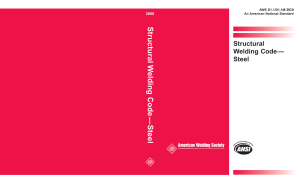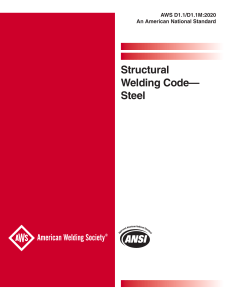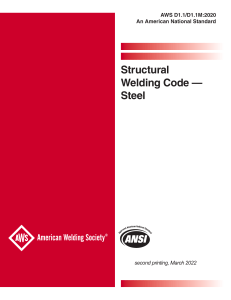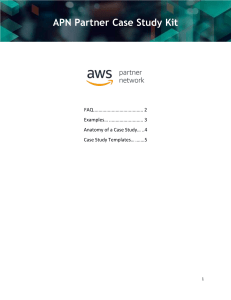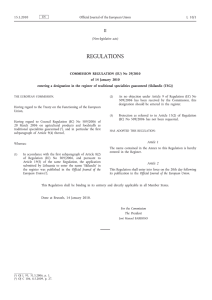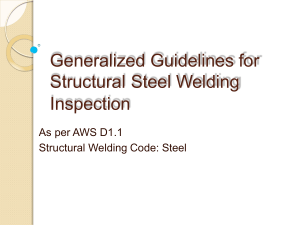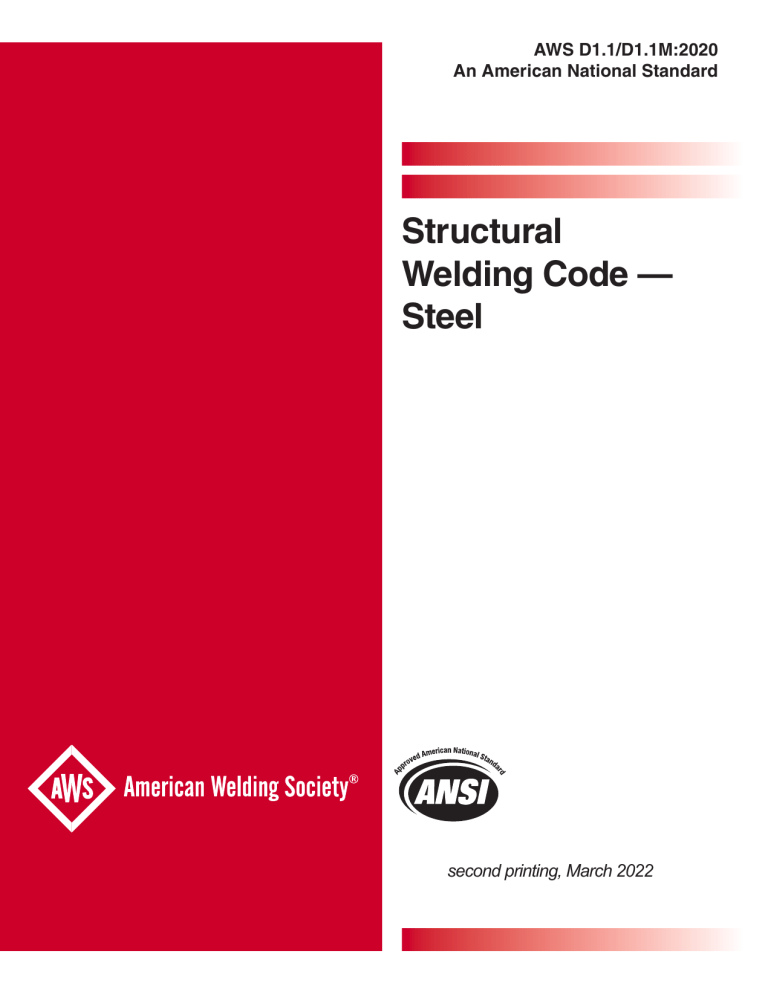
AWS D1.1/D1.1M:2020 An American National Standard Structural Welding Code — Steel second printing, March 2022 AWS D1.1/D1.1M:2020 An American National Standard Approved by the American National Standards Institute December 9, 2019 Structural Welding Code—Steel 24th Edition Supersedes AWS D1.1/D1.1M:2015 Prepared by the American Welding Society (AWS) D1 Committee on Structural Welding Under the Direction of the AWS Technical Activities Committee Approved by the AWS Board of Directors Abstract This code covers the welding requirements for any type of welded structure made from the commonly used carbon and low-alloy constructional steels. Clauses 1 through 11 constitute a body of rules for the regulation of welding in steel construction. There are eight normative and eleven informative annexes in this code. A Commentary of the code is included with the document. AWS D1.1/D1.1M:2020 ISBN Print: 978-1-64322-087-1 ISBN PDF: 978-1-64322-088-8 © 2020 by American Welding Society All rights reserved Printed in the United States of America Errata: Second Printing, March 2022 Photocopy Rights. No portion of this standard may be reproduced, stored in a retrieval system, or transmitted in any form, including mechanical, photocopying, recording, or otherwise, without the prior written permission of the copyright owner. Authorization to photocopy items for internal, personal, or educational classroom use only or the internal, personal, or educational classroom use only of specific clients is granted by the American Welding Society provided that the appropriate fee is paid to the Copyright Clearance Center, 222 Rosewood Drive, Danvers, MA 01923, tel: (978) 750-8400; Internet: <www.copyright.com>. ii AWS D1.1/D1.1M:2020 Statement on the Use of American Welding Society Standards All standards (codes, specifications, recommended practices, methods, classifications, and guides) of the American Welding Society (AWS) are voluntary consensus standards that have been developed in accordance with the rules of the American National Standards Institute (ANSI). When AWS American National Standards are either incorporated in, or made part of, documents that are included in federal or state laws and regulations, or the regulations of other governmental bodies, their provisions carry the full legal authority of the statute. In such cases, any changes in those AWS standards must be approved by the governmental body having statutory jurisdiction before they can become a part of those laws and regulations. In all cases, these standards carry the full legal authority of the contract or other document that invokes the AWS standards. Where this contractual relationship exists, changes in or deviations from requirements of an AWS standard must be by agreement between the contracting parties. AWS American National Standards are developed through a consensus standards development process that brings together volunteers representing varied viewpoints and interests to achieve consensus. While AWS administers the process and establishes rules to promote fairness in the development of consensus, it does not independently test, evaluate, or verify the accuracy of any information or the soundness of any judgments contained in its standards. AWS disclaims liability for any injury to persons or to property, or other damages of any nature whatsoever, whether special, indirect, consequential, or compensatory, directly or indirectly resulting from the publication, use of, or reliance on this standard. AWS also makes no guarantee or warranty as to the accuracy or completeness of any information published herein. In issuing and making this standard available, AWS is neither undertaking to render professional or other services for or on behalf of any person or entity, nor is AWS undertaking to perform any duty owed by any person or entity to someone else. Anyone using these documents should rely on his or her own independent judgment or, as appropriate, seek the advice of a competent professional in determining the exercise of reasonable care in any given circumstances. It is assumed that the use of this standard and its provisions is entrusted to appropriately qualified and competent personnel. This standard may be superseded by new editions. This standard may also be corrected through publication of amendments or errata, or supplemented by publication of addenda. Information on the latest editions of AWS standards including amendments, errata, and addenda is posted on the AWS web page (www.aws.org). Users should ensure that they have the latest edition, amendments, errata, and addenda. Publication of this standard does not authorize infringement of any patent or trade name. Users of this standard accept any and all liabilities for infringement of any patent or trade name items. AWS disclaims liability for the infringement of any patent or product trade name resulting from the use of this standard. AWS does not monitor, police, or enforce compliance with this standard, nor does it have the power to do so. Official interpretations of any of the technical requirements of this standard may only be obtained by sending a request, in writing, to the appropriate technical committee. Such requests should be addressed to the American Welding Society, Attention: Director, Standards Development, 8669 NW 36 St, # 130, Miami, FL 33166 (see Annex T). With regard to technical inquiries made concerning AWS standards, oral opinions on AWS standards may be rendered. These opinions are offered solely as a convenience to users of this standard, and they do not constitute professional advice. Such opinions represent only the personal opinions of the particular individuals giving them. These individuals do not speak on behalf of AWS, nor do these oral opinions constitute official or unofficial opinions or interpretations of AWS. In addition, oral opinions are informal and should not be used as a substitute for an official interpretation. This standard is subject to revision at any time by the AWS D1 Committee on Structural Welding. It must be reviewed every five years, and if not revised, it must be either reaffirmed or withdrawn. Comments (recommendations, additions, or deletions) and any pertinent data that may be of use in improving this standard are requested and should be addressed to AWS Headquarters. Such comments will receive careful consideration by the AWS D1 Committee on Structural Welding and the author of the comments will be informed of the Committee’s response to the comments. Guests are invited to attend all meetings of the AWS D1 Committee on Structural Welding to express their comments verbally. Procedures for appeal of an adverse decision concerning all such comments are provided in the Rules of Operation of the Technical Activities Committee. A copy of these Rules can be obtained from the American Welding Society, 8669 NW 36 St, # 130, Miami, FL 33166. iii AWS D1.1/D1.1M:2020 This page is intentionally blank. iv AWS D1.1/D1.1M:2020 Personnel AWS D1 Committee on Structural Welding TRC Solutions Fickett Structural Solutions, LLC High Steel Structures, LLC American Welding Society Subsea Global Solutions IISI Thom Burns Consulting, LLC Pazuzu Engineering Bechtel Eustis Engineering, LLC APTIM (Retired) Midwest Steel, Incorporated MA Department of Transportation Shell International E&P ConocoPhillips (Retired) Trinity Consultants Los Alamos National Laboratory Lexicon, Incorporated American Engineering and Manufacturing, Incorporated Project & Quality Solutions Canadian Welding Bureau Moonshine Hill Proprietary Systems Engineering Terracon Consultants D. L. McQuaid & Associates, Incorporated TRC Solutions The Lincoln Electric Company ALRV Consultant, LLC Rager Consulting, Incorporated American Institute of Steel Construction Steel Structures Technology Center, Incorporated Pennoni Associates, Incorporated Williams Enterprises of GA, Incorporated (Retired) A. W. Sindel, Chair T. L. Niemann, Vice Chair R. D. Medlock, 2nd Vice Chair J. A. Molin, Secretary U. W. Aschemeier E. L. Bickford T. M. Burns H. H. Campbell, III R. D. Campbell B. Connelly R. B. Corbit M. E. Gase M. A. Grieco J. J. Kenney J. H. Kiefer J. R. Kissell B. Krueger V. Kuruvilla J. Lawmon N. S. Lindell D. R. Luciani P. W. Marshall M. J. Mayes D. L. McQuaid J. Merrill D. K. Miller J. B. Pearson, Jr. D. D. Rager T. J. Schlafly R. E. Shaw, Jr. M. M. Tayarani P. Torchio, III Advisors to the D1 Committee on Structural Welding STV Incorporated The Lincoln Electric Company Consultant HRV Conformance Verification Associates, Incorporated G.J. Hill & Associates Consultant Modjeski & Masters, Inc. (Retired) Retired N. J. Altebrando F. G. Armao G. L. Fox H. E. Gilmer G. J. Hill M. L. Hoitomt C. W. Holmes G. S. Martin v AWS D1.1/D1.1M:2020 Advisors to the D1 Committee on Structural Welding (Continued) Retired Sandia National Laboratories J. W. Post & Associates, Incorporated Parsons Corporation Consultant D. C. Phillips P. G. Kinney J. W. Post R. W. Stieve K. K. Verma Active Past AWS D1 Main Committee Chairs D.L. McQuaid & Assoc. Incorporated The Lincoln Electric Company Rager Consulting, Incorporated D. L. McQuaid D. K. Miller D. D. Rager AWS D1Q Subcommittee on Steel American Institute of Steel Construction Williams Enterprises of GA, Incorporated (Retired) American Welding Society Subsea Global Solutions C-Spec IISI Pazuzu Engineering Retired Midwest Steel, Incorporated HRV Conformance Verification Associates, Incorporated Stanley Black & Decker–Nelson Stud Welding Shell International E&P Conoco Philips (Retired) Sandia National Laboratories LeJeune Steel Company Lexicon, Incorporated Canadian Welding Bureau Moonshine Hill Proprietary Systems Engineering Kiewit Offshore Services, LTD. Retired Terracon Consultants TRC Solutions Chevron American Hydro Corporation ExxonMobil Entergy Rager Consulting, Incorporated Steel Structures Technology Center, Incorporated TRC Solutions McDermott T. J. Schlafly, Chair P. Torchio, III, Vice Chair J. A. Molin, Secretary U. W. Aschemeier M. Bernasek E. L. Bickford H. H. Campbell, III R. V. Clarke M. E. Gase H. E. Gilmer W. S. Houston J. J. Kenney J. H. Kiefer P. G. Kinney L. Kloiber V. Kuruvilla D. R. Luciani P. W. Marshall R. P. Marslender G. S. Martin M. J. Mayes J. Merrill J. I. Miller S. P. Moran T. C. Myers J. C. Nordby D. D. Rager R. E. Shaw, Jr. A. W. Sindel J. L. Warren Advisors to the D1Q Committee on Steel STV Incorporated Walt Disney World Company Schuff Steel Walt Disney World Company SNH Market Consultants MA Department of Transportation N. J. Altebrando B. M. Butler J. W. Cagle B. Capers H. A. Chambers M. A. Grieco vi AWS D1.1/D1.1M:2020 Advisors to the D1Q Committee on Steel (Continued) Tru-Weld Equipment Company The Lincoln Electric Company Arc Specialties Modjeski & Masters, Inc. (Retired) Johnson Plate and Tower Fabrication Stud Welding Products Incorporated Project & Quality Systems D. L. McQuaid & Associates, Incorporated High Steel Structures The Lincoln Electric Company University of Toronto ALRV Consultant, LLC Retired J. W. Post & Associates, Incorporated Parsons Corporation MA Department of Transportation Consultant Consultant Tru-Weld Wright Welding Technologies J. Guili C. W. Hayes R. L. Holdren C. W. Holmes M. J. Jordan J. E. Koski N. S. Lindell D. L. McQuaid R. D. Medlock D. K. Miller J. A. Packer J. B. Pearson, Jr. D. C. Phillips J. W. Post R. W. Stieve M. M. Tayarani S. J. Thomas K. K. Verma P. Workman D. A. Wright D1Q Subcommittee Task Group on Design American Institute of Steel Construction The Lincoln Electric Company Wiss, Janney, Elstner Associates Ferrell Engineering, Incorporated Johnson Plate and Tower Fabrication Shell International E & P LeJeune Steel Company Moonshine Hill Proprietary Systems Engineering Federal Highway Administration University of Toronto ALRV Consultant, LLC Steel Structures Technology Center, Incorporated Wiss, Janney, Elstner Associates T. J. Schlafly, Co-Chair D. K. Miller, Co-Chair T. Green, Vice Chair D. B. Ferrell M. J. Jordan J. J. Kenney L. A. Kloiber P. W. Marshall J. M. Ocel J. A. Packer J. B. Pearson, Jr. R. E. Shaw, Jr. R. H. R. Tide Advisors to the D1Q Subcommittee Task Group on Design Walt Disney World Company Bombardier Transportation B. Capers J. Desjardins D1Q Subcommittee Task Group on Prequalification Canadian Welding Bureau NCI Building Systems Atlantic Testing Laboratories Pazuzu Engineering Precision Custom Components Canadian Welding Bureau MHP Systems Engineering The Lincoln Electric Company Chevron C. Zanfir, Chair L. M. Bower, Vice Chair W. J. Bell H. H. Campbell, III M. D. Florczykowski D. R. Luciani P. W. Marshall D. K. Miller J. I. Miller vii AWS D1.1/D1.1M:2020 D1Q Subcommittee Task Group on Prequalification (Continued) American Hydro Corporation Entergy Steel Structures Technology Center, Incorporated TRC Solutions Williams Enterprises of Georgia, Incorporated (Retired) S. P. Moran J. C. Norby R. E. Shaw, Jr. A.W. Sindel P. Torchio, III D1Q Subcommittee Task Group on Qualification ExxonMobil CB&I Power C-Spec IISI Accurate Weldment Testing, LLC Idaho National Laboratory Arc Specialties Shell International E & P ConocoPhillips Company (Retired) Kiewit Offshore Services, Ltd. Arcosa Meyers Utility Structures ESAB Welding & Cutting Products Kawasaki Motors Manufacturing Corporation USA Rager Consulting, Incorporated TRC Solutions Caterpillar, Incorporated CB&I Miller Electric Manufacturing Company T. C. Myers, Chair S. J. Findlan, Vice Chair M. Bernasek E. L. Bickford T. R. Blissett M. J. Harker R. L. Holdren J. J. Kenney J. H. Kiefer R. P. Marslender J. R. McGranaghan D. W. Meyer J. D. Niemann D. D. Rager A. W. Sindel D. A. Stickel B. M. Toth K. K. Welch Advisors to the D1Q Subcommittee Task Group on Qualification Retired Retired Consultant G. S. Martin D. C. Phillips K. K. Verma D1Q Subcommittee Task Group on Fabrication Chevron Midwest Steel, Incorporated Anderson Inspections NCI Building Systems Pazuzu Engineering Retired HRV Conformance Verification Associates, Incorporated Massachusetts Department of Transportation Tishman AECOM ConocoPhillips Company (Retired) Sandia National Laboratories Lexicon, Incorporated Retired New York City Department of Buildings High Steel Structures, LLC Pennoni Associates, Incorporated Alta Vista Solutions Pennoni J. I. Miller, Chair M. E. Gase, Vice Chair S. E. Anderson L. N. Bower H. H. Campbell, III R. V. Clarke H. E. Gilmer M. A. Grieco C. Carbonneau J. H. Kiefer P. G. Kinney V. Kuruvilla G. S. Martin E. S. Mattfield R. D. Medlock J. E. Mellinger R. L. Mertz R. E. Monson viii AWS D1.1/D1.1M:2020 Advisors to the D1Q Subcommittee Task Group on Fabrication WGAPE Molex Incorporated C. P. Buckner Steel Erection, Incorporated Consultant G. J. Hill & Associates ARC Specialties Modjeski & Masters, Incorporated (Retired) D. L. McQuaid & Associates, Incorporated Consultant J. W. Post and Associates, Incorporated American Institute of Steel Construction Trinity Industries, Incorporated Consultant W. G. Alexander B. Anderson J. W. Cagle G. L. Fox G. J. Hill R. L. Holdren C. W. Holmes D. L. McQuaid J. E. Myers J. W. Post T. J. Schlafly J. F. Sokolewicz K. K. Verma D1Q Subcommittee Task Group on Inspection Sandia National Laboratories Caltrop Corporation Midwest Steel, Incorporated Anderson Inspections Subsea Global Solutions Retired Kiewit Corporation NDE-Olympus NDT-University Ultrasonics Consultant HRV Conformance Verification Associates, Incorporated The Lincoln Electric Company GE Inspection Technologies, LP KTA-Tator, Incorporated Product of Quality Solutions Retired New York City Department of Buildings Pennoni Associates, Incorporated TRC Solutions Alta Vista Solutions Pennoni Associates, Incorporated ALRV Consultant, LLC Nova HRV Conformance Verification Associates, Incorporated Consultant P. G. Kinney, Chair J. J. Kinsey, Vice Chair M. E. Gase, 2 Vice Chair S. E. Anderson U. W. Aschemeier R. V. Clarke J. A. Cochran J. M. Davis P. A. Furr H. E. Gilmer C. W. Hayes P. T. Hayes J. K. Hilton N. S. Lindell G. S. Martin E. S. Mattfield J. E. Mellinger J. Merrill R. L. Mertz R. E. Monson J. B. Pearson, Jr. C. E. Pennington R. E. Stachel K. J. Steinhagen Advisors to the D1Q Subcommittee Task Group on Inspection PSI (Retired) DOT Quality Services G. J. Hill & Associates Alstom Power ConocoPhillips Company (Retired) Shell International Exploration & Production D.L. McQuaid & Associates, Incorporated Canadian Welding Bureau D. A. Dunn J. J. Edwards G. J. Hill R. K. Holbert J. H. Kiefer C. A. Mankenberg D. L. McQuaid D. G. Yantz ix AWS D1.1/D1.1M:2020 D1Q Subcommittee Task Group on Stud Welding Stanley Black & Decker–Nelson Stud Welding Subsea Global Solutions Bechtel Consultant Image Industries Stanley Black & Decker–Nelson Stud Welding Stud Welding Products, Incorporated Canadian Welding Bureau Cox Industries American Hydro Corporation Williams Enterprises of Georgia, Incorporated (Retired) Stone & Webster, Incorporated Tru-Weld Equipment Company W. S. Houston, Chair U. W. Aschemeier, Vice Chair R. D. Campbell A. D. D’Amico B. C. Hobson I. W. Houston J. E. Koski D. R. Luciani C. W. Makar S. P. Moran P. Torchio, III J. S. Wirtz P. Workman Advisors to the D1Q Subcommittee Task Group on Stud Welding Stanley Black & Decker–Nelson Stud Welding Tru-Weld Equipment Company Stanley Black & Decker–Nelson Stud Welding Pennoni Associates, Incorporated C. B. Champney J. Guili R. Schraff M. M. Tayarani D1Q Standing Task Group on Tubulars Shell International E & P Massachusetts Department of Transportation IISI California Department of Transportation Retired Ferrell Engineering, Incorporated Atlas Tube Gill Engineering Associates, Incorporated LeJeune Steel Consultant Consultant Moonshine Hill Proprietary Systems Engineering Kiewit Offshore Services, Ltd. University of Michigan Alta Vista Solutions Pennoni Associates, Incorporated FORSE Consulting-Steel Tube Institute University of Toronto Sougata Roy, LLC ATLSS Center Lehigh University J. J. Kenney, Chair M. A. Grieco, Vice Chair E. L. Bickford N. M. Choy R. V. Clarke D. B. Ferrell R. B. Fletcher P. A. Huckabee L. A. Kloiber C. Long P. W. Marshall R. P. Marslender J. P. McCormick R. L. Mertz R. E. Monson K. T. Olson J. A. Packer R. Sougata R. Sause Advisors to the D1Q Standing Task Group on Tubulars DOT Quality Services Lexicon, Incorporated Terracon Consultants High Steel Structures, LLC Fickett Structural Solutions, LLC Rager Consulting, Incorporated American Institute of Steel Construction TRC Solutions J. J. Edwards V. Kuruvilla M. J. Mayes R. D. Medlock T. L. Niemann D. D. Rager T. J. Schlafly A. W. Sindel x AWS D1.1/D1.1M:2020 D1M Standing Task Group on New Materials McDermott American Institute of Steel Construction Arcelor Mittal Hobart Brothers Company Washington State Universtiy Lexicon, Incorporated High Steel Structures, LLC ESAB Welding & Cutting Products LTK Engineering Services Sargent & Lundy, LLC Rager Consulting, Incorporated Nucor-Yamato Steel McDermott M. D. Kerr, Chair T. J. Schlafly, Vice Chair R. S. Caroti C. Haven D. A. Koch V. Kuruvilla R. D. Medlock D. W. Meyer T. M. Nelson P. R. Niewiarowski D. D. Rager J. L. Schoen J. L. Warren Advisors to the D1M Standing Task Group on New Materials Walt Disney World Company Arcelor Mittal The Lincoln Electric Company Consultant ALRV Consultant, LLC Retired J. W. Post & Associates, Incorporated Steel Dynamics TRC Solutions B. Capers S. C. Finnigan C. W. Hayes M. L. Hoitomt J. B. Pearson, Jr. D. C. Phillips J. W. Post D. Rees-Evans A. W. Sindel xi AWS D1.1/D1.1M:2020 This page is intentionally blank. xii AWS D1.1/D1.1M:2020 Foreword This foreword is not part of AWS D1.1/D1.1M:2020, Structural Welding Code—Steel, but is included for informational purposes only. The first edition of the Code for Fusion Welding and Gas Cutting in Building Construction was published by the American Welding Society in 1928 and called Code 1 Part A. It was revised in 1930 and 1937 under the same title. It was revised again in 1941 and given the designation D1.0. D1.0 was revised again in 1946, 1963, 1966, and 1969. The 1963 edition published an amended version in 1965, and the 1966 edition published an amended version in 1967. The code was combined with D2.0, Specifications for Welding Highway and Railway Bridges, in 1972, given the designation D1.1, and retitled AWS Structural Welding Code. D1.1 was revised again in 1975, 1979, 1980, 1981, 1982, 1983, 1984, 1985, 1986, 1988, 1990, 1992, 1994, 1996, 1998, 2000, 2002, 2004, 2006, 2008 and 2010. A second printing of D1.1:2010 was published in 2011. From 1972 to 1988, the D1.1 code covered the welding of both buildings and bridges. In 1988, AWS published its first edition of AASHTO/AWS D1.5, Bridge Welding Code; coincident with this, the D1.1 code changed references of buildings and bridges to statically loaded and dynamically loaded structures, respectively, in order to make the document applicable to a broader range of structural applications. After the publishing of the 2010 edition, it was decided that the AWS Structural Welding Code—Steel would be published on a five year revision cycle instead of a two year revision cycle. This was done in order to sync the publication cycle of AWS Structural Welding Code-Steel with the publication cycles of the AISC Steel Building Specification and the International Building Code. This 2020 edition is the 24th edition of D1.1. Changes in Code Requirements, underlined text in the clauses, subclauses, tables, figures, or forms indicates a change from the 2015 edition. A vertical line in the margin of a table or figure also indicates a change from the 2015 edition. The following is a summary of the most significant technical changes contained in D1.1/D1.1M:2020: Summary of Changes Clause/Table/Figure/Annex Modification Clause 1 Clause 2 This is a new clause listing normative references. It replaces subclause 1.9 and Annex S from the previous edition. Clause 3 This is a new clause that provides terms and definitions specific to this standard. It replaces subclause 1.3 and Annex J from the previous edition. Clause 4 Clause 4 was presented as Clause 2 in the previous edition. Annex A Figures in the previous edition were incorporated into Clause 4. Clause 5 Clause 5 was presented as Clause 3 in the previous edition. The Clause has also been restructured to follow the normal progression of writing a prequalified WPS. Table 5.2 has been editorially renamed and reorganized to list WPS essential variables. Additional requirements have been added when using shielding gases and a new Table 5.7 was added on shielding gases. New materials have been added to Tables 5.3 and 5.8. Clause 6 Clause 6 was presented as Clause 4 in the previous edition. Revisions include the requirements for the qualification of WPSs using waveform technology. All the CVN testing requirements have been added to Table 6.7, so they now are all contained in a single place. The WPS retest requirements have been clarified. The PJP Groove weld clause has been reorganized to clarify the qualification of PJP Groove welds using the Joint Details in Figure 5.2. Part D of the Clause has been reorganized to better align the testing procedures and qualification of CVNs with the order that they would be accomplished. (Continued) xiii AWS D1.1/D1.1M:2020 Summary of Changes (Continued) Clause/Table/Figure/Annex Modification Clause 7 Clause 7 was presented as Clause 5 in the previous edition. Revisions were made to the weld restoration of base metal with mislocated holes. Clause 8 Clause 8 was presented as Clause 6 in the previous edition. Revisions were made to the qualification requirements for inspection personnel to ensure that all welding inspectors are qualified. The Engineer’s responsibilities as it relates to Inspection were also clarified. Digital radiography has been added to Radiographic Testing. The limitations for geometric unsharpness have been added to the Code and the equation has been revised to match the equation in ASME Boiler and Pressure Vessel Code, Section V, Article 2. The methodology to determine the attenuation factor has been updated to reflect that UT instruments are now capable of reporting a fractional value for dB. Clause 9 Clause 9 was presented as Clause 7 in the previous edition. The code was updated to require the manufacturer’s permanent identification on headed studs and deformed anchor bars. Revisions were made to provide weld procedure requirements for fillet welding of studs. Clause 10 Clause 10 was presented as Clause 9 in the previous edition. The calculations for static strength of welded tubular connections were removed in deference to AISC design provisions. Clause 11 Clause 11 was presented as Clause 8 in the previous edition. Annex A Annex A was presented as Annex B in the previous edition. Annex B Annex B was presented as Annex H in the previous edition. Annex D Annex D was presented as Annex F in the previous edition. Annex E Annex E was presented as Annex D in the previous edition. Annex F Annex F was presented as Annex E in the previous edition. Annex H New Annex that addresses phased array ultrasonic testing (PAUT) Annex J Annex J was presented as Annex M in the previous edition. Annex K Annex K was presented as Annex P in the previous edition. Annex L Annex L was presented as Annex T in the previous edition. Annex M Annex M was presented as Annex U in the previous edition. Annex N Annex N was presented as Annex K in the previous edition. Annex O Annex O was presented as Annex Q in the previous edition. Annex P Annex P was presented as Annex L in the previous edition. Annex Q Annex Q was presented as Annex O in the previous edition. Annex R Annex R has been modified to contain preliminary design of circular tube connections previously contained in the Tubular Structures clause as well as ovalizing parameter alpha. Annex T Annex T was presented as Annex N in the previous edition. C-Annex H Commentary was added for Annex H Commentary. The Commentary is nonmandatory and is intended only to provide insightful information into provision rationale. Normative Annexes. These annexes address specific subjects in the code and their requirements are mandatory requirements that supplement the code provisions. Informative Annexes. These annexes are not code requirements but are provided to clarify code provisions by showing examples, providing information, or suggesting alternative good practices. Index. As in previous codes, the entries in the Index are referred to by subclause number rather than by page number. This should enable the user of the Index to locate a particular item of interest in minimum time. (Continued) xiv AWS D1.1/D1.1M:2020 Errata. It is the Structural Welding Committee’s Policy that all errata should be made available to users of the code. Therefore, any significant errata will be published in the Society News Section of the Welding Journal and posted on the AWS web site at: http://www.aws.org/standards/page/errata. Suggestions. Your comments for improving AWS D1.1/D1.1M:2015, Structural Welding Code—Steel are welcome. Submit comments to the Secretary of the D1Q Subcommittee, American Welding Society, 8669 NW 36 St, # 130, Miami, FL 33166. xv AWS D1.1/D1.1M:2020 Errata The following Errata have been identified and are incorporated in this reprint. Page 9, term *dihedral angle: a return is missing between “See local dihedral angle” and “discontinuity” *dihedral angle. See local dihedral angle. discontinuity. An interruption of the typical structure of a material, such as a lack of homogeneity in its mechanical or metallurgical, or physical characteristics. A discontinuity is not necessarily a defect. Page 11, the symbol should be ϕ not θ. *groove angle, ϕ (tubular structures). The angle between opposing faces of the groove to be filled with weld metals, determined after the joint is fit-up. Page 11, the term interpass temperature is missing the asterisk. *interpass temperature. In a multipass weld, the temperature of the weld area between weld passes. Page 12, the symbol should be Ψ not θ. *local dihedral angle, Ψ (tubular structures). The angle, measured in a plane perpendicular to the line of the weld, between tangents to the outside surfaces of the tubes being joined at the weld. The exterior dihedral angle, where one looks at a localized section of the connection, such that the intersecting surfaces may be treated as planes. Page 13, the term preheat temperature, welding is missing the asterisk. *preheat temperature, welding. The temperature of the base metal in the volume surrounding the point of welding immediately before welding is started. In a multiple-pass weld, it is also the temperature immediately before the second and subsequent passes are started. Page 14, top of page *single electrode ,*parallel electrode, * multiple electrode moved to below the definition of SAW. Submerged arc welding (SAW). An arc welding process that uses an arc or arcs between a bare metal electrode or electrodes and the weld pool. The arc and molten metal are shielded by a blanket of granular flux on the workpieces. The process is used without pressure and with filler metal from the electrode and sometimes from a supplemental source (welding rod, flux, or metal granules). *single electrode. One electrode connected exclusively to one power source which may consist of one or more power units. *parallel electrode. Two electrodes connected electrically in parallel and exclusively to the same power source. Both electrodes are usually fed by means of a single electrode feeder. Welding current, when specified, is the total for the two. *multiple electrodes. The combination of two or more single or parallel electrode systems. Each of the component systems has its own independent Page 42, Table 4.5 entitled “Fatigue Stress Design Parameters (see 4.14.1)” -Description 5.6 replace “Formula 4” with “Formula 5” -Description 5.7 replace “Formula 4” with “Formula 5” -Description 8.2 replace “Formula 3” with “Formula 4” -Description 8.4 replace “Formula 3” with “Formula 4” Page 63, Clause 5.4.1 -Replace the reference “5.4.1.1” with “5.4.1.1 through 5.4.1.9.” Page 69, Table 5.2 entitled “Essential Variables for Prequalified WPSs (see 5.2.1)” -item (4) Base Metal Preheat Category(s) replace “(See Table 5.4)” with “(See Table 5.8)”. xvi
